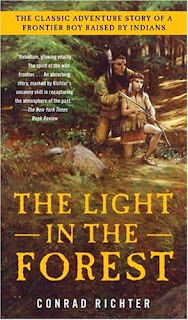I am creating a unit on Native-Americans and focusing on literacy by using two anchor texts. The anchor texts for the unit include two books, Conrad Richter: The Light in the Forest, and Happily May I Walk by Arlene Hirschfelder. The Light in the Forest is written as historical fiction but it is based on true events of Native-Americans holding captive White settlers as well as White settlers holding captive Native-Americans. Happily May I Walk is a non-fiction book about Native-American culture and the examination of the multiple aspects of Native-Americans in the 21st century. Students will be comparing and contrasting fiction and non-fiction readings in terms of their approaches to similar themes and topics. Students will also draw evidence from literary or informational texts to support analysis, reflection, and research in the form of short essays and personal narratives. This unit is intended for sixth graders. It meets the Illinois common core state standards for reading #9, and writing #9a standards for sixth grade.
QR Codes
QR code is an abbreviation for
quick response code. They are a type of matrix bar-codes that can encode
information whether it is a link to a URL, text, image, or video. QR codes can
be decoded through smartphones, tablets, and other devices that have a camera
and a QR code app. They are not easy to make nor are they complex to create. With
some basic technological knowledge one can find a QR code generator website and
follow their steps to create a QR code. Some websites charge to generate QR
codes, while others don’t. It took me awhile to find a FREE QR code generator
website. The FREE QR code website that I prefer is QR Code Maker because it has detailed
steps to help one create QR codes and it’s FREE. After one makes a several QR
codes I suggest to make a Word document and then upload it to Scribd to share it with others for free. With
some guidance, teachers and students should be able to create them within
thirty minutes. QR codes bring a sense of excitement to lessons because they
have a mysterious aspect since student feel like detectives using gadgets to
decipher the hidden answers linked within the QR codes.
QR Codes: Native-American Unit
Since this unit centers around
Native-Americans I decided to arouse the students’ curiosity by using QR codes
in an anticipatory activity. Before we begin reading either of the books, this
activity will allow students to explore and engage them in learning about Native-Americans.
This activity will prompt students to answer questions about Native-Americans
such as “how did Native-Americans travel?” and “ did all Native-Americans speak
the same language?”. These previous questions will help immerse students in the
unit’s topic. Another question that they will answer via a QR code will be “name
one reason there was conflict between the Native-Americans and the new settlers”
will help set up the class dialogue leading to The Light in the Forest. This QR code activity took me forty
minutes to make because I took time choosing which questions would best fit
into this activity. The QR codes generating process was easy once I became
accustomed using the tool after the third QR code I generated. Teachers can
formulate other questions and or images/videos that can direct students to
informative links via QR codes for this unit and other units/topics so don’t feel
restricted using this tool. As mentioned before students will love the mysterious detective aspect of QR codes which will surely engage them in any topic.
*My link to this QR
codes anticipatory activity is right below the screenshot of the worksheet.*
*If you have any other ideas
for which QR codes could be integrated in this unit please share them with me
via the comments section.*




